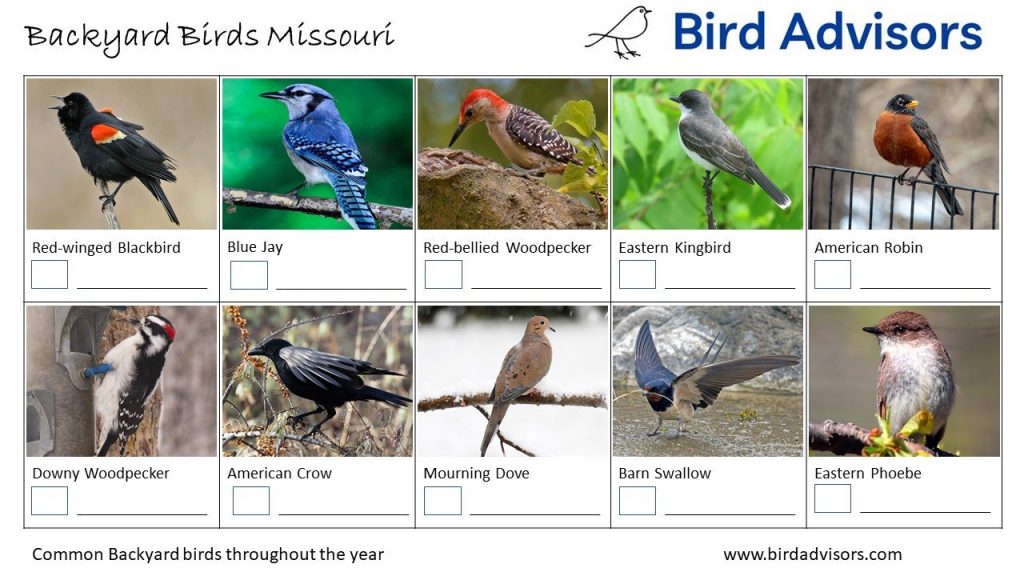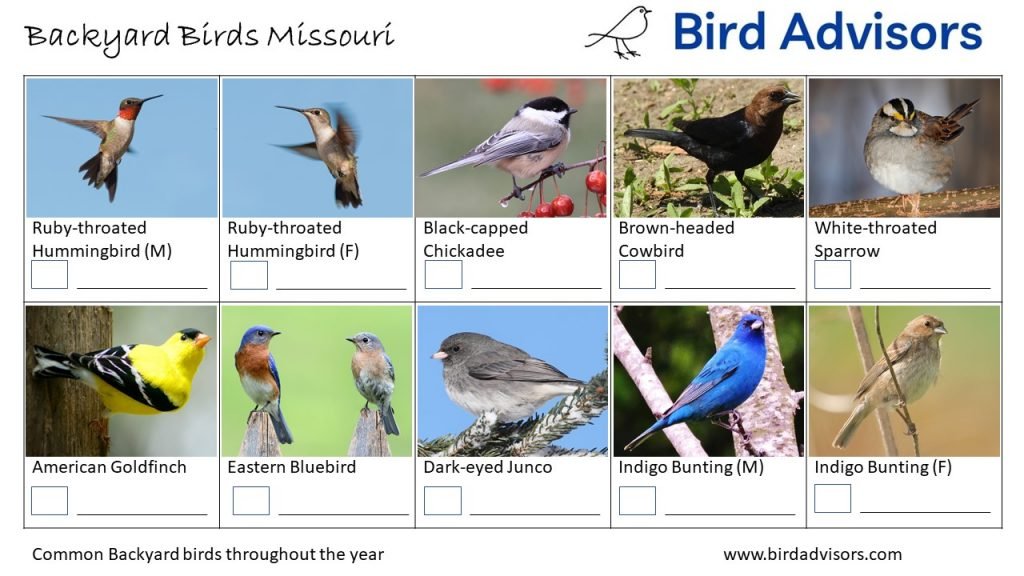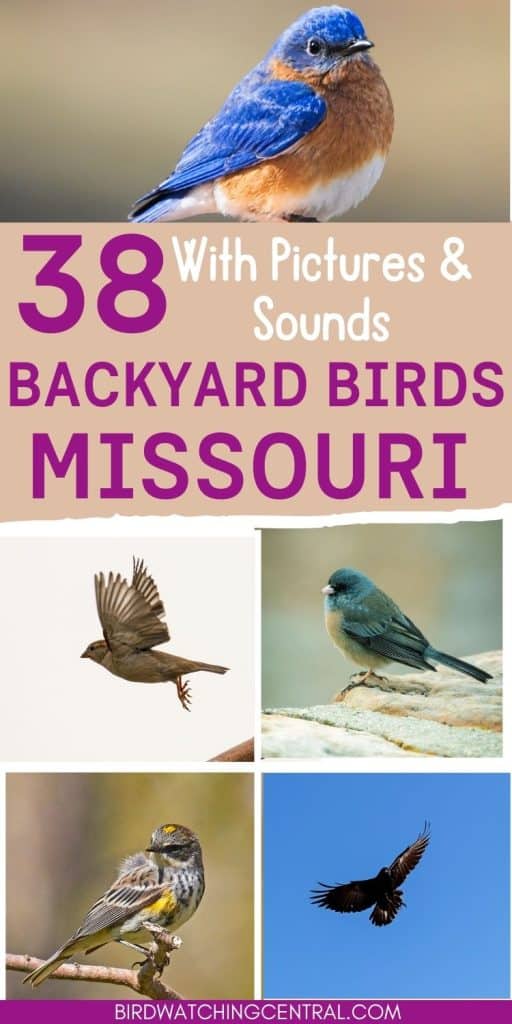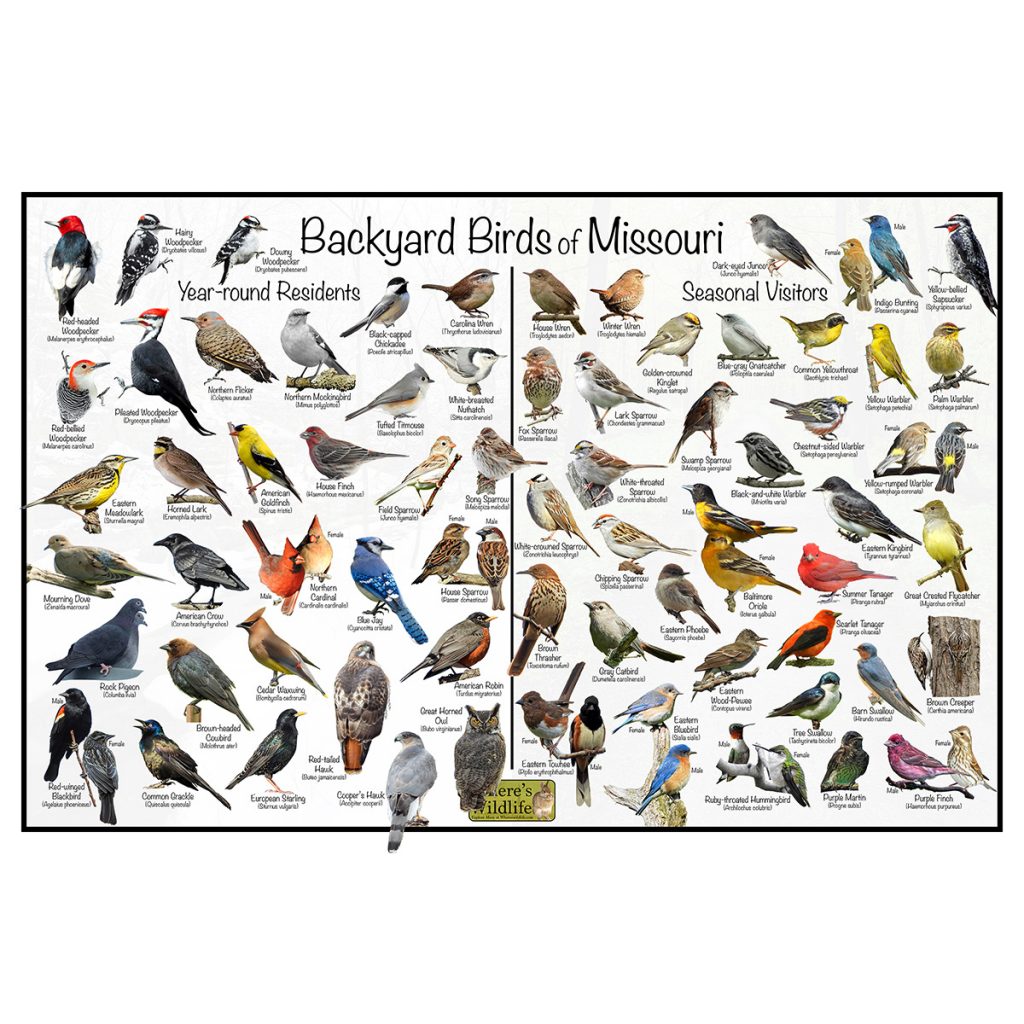Get ready to explore the fascinating world of backyard birds in Missouri! In this article, you’ll uncover essential information about 32 common species found in your very own backyard. With data compiled from the renowned citizen science program eBird, you can trust that this article provides accurate and reliable insights. Each bird species is accompanied by captivating pictures and valuable tips on how to attract them to your backyard. You’ll discover that the Northern Cardinal proudly holds the title of the most common bird in Missouri, closely followed by the majestic Blue Jay, the gentle Mourning Dove, and the lively American Robin. As you delve into this article, you’ll also gain a deeper understanding of birds and bird watching in Missouri, and find valuable resources for further exploration. Get ready to be amazed by the beauty and diversity of these feathered friends right at your doorstep!
Overview of Birds and Bird Watching in Missouri
Missouri is a bird lover’s paradise, with its diverse landscape and abundant birdlife. Bird watching, also known as birding, is a popular recreational activity that allows individuals to observe and appreciate the beauty of these feathered creatures. Not only is bird watching an enjoyable hobby, but it also provides important scientific data that contributes to our understanding of bird populations and their behavior. This article aims to provide a comprehensive overview of birds and bird watching in Missouri, including the importance of bird watching, bird habitats, migration patterns, and endangered bird species.

Importance of Bird Watching
Bird watching holds great significance in both ecological and recreational contexts. It allows individuals to connect with nature and appreciate the beauty of avian species. Through observation and documentation, bird watchers contribute valuable data to scientific research, aiding in the understanding and conservation of these majestic creatures. Moreover, bird watching promotes environmental awareness and assists in detecting changes in ecosystems, such as the impacts of climate change. Overall, bird watching serves as a means to foster a deeper appreciation for the natural world and contributes to the conservation of bird populations.
Bird Habitats in Missouri
Missouri encompasses a diverse range of habitats, providing a home to a wide array of bird species. From forests and prairies to wetlands and rivers, the state offers diverse ecosystems that harbor diverse bird populations. Forested areas such as Mark Twain National Forest and Ozark National Scenic Riverways are rich in species like the Northern Cardinal, Blue Jay, and Downy Woodpecker. Prairies and grasslands provide habitats for Meadowlarks, Eastern Bluebirds, and the striking Indigo Bunting. Furthermore, wetlands and marshes support waterfowl such as the Great Blue Heron and Yellow Warbler. Overall, Missouri’s diverse habitat types make it a prime birding destination for enthusiasts of all levels.
Migration of Birds
Migration is a natural phenomenon in which birds travel long distances between their breeding grounds and wintering grounds. Missouri is situated in the heart of the Mississippi Flyway, a major migratory route for birds traveling between their summer breeding grounds in North America and their wintering grounds in Central and South America. Thousands of birds pass through or make a stopover in Missouri during their biannual journeys. Wetlands and shorelines along the Mississippi and Missouri rivers serve as critical stopover points for resting and refueling. Bird watchers are treated to the stunning sight of flocks of Sandhill Cranes, ducks, geese, and various raptors as they make their way through the state.
Endangered Bird Species in Missouri
Despite the rich birdlife in Missouri, several species face the risk of population decline and potential extinction. A few of the endangered bird species in the state include the Kirtland’s Warbler, Least Tern, and Red-cockaded Woodpecker. Habitat destruction, pollution, and climate change are some of the leading factors contributing to the decline of these species. Efforts are being made by conservation organizations, such as the Missouri Department of Conservation, to protect and restore the habitats of these endangered birds. Bird watchers can play a vital role in the conservation efforts by participating in citizen science programs and reporting their sightings to contribute to population monitoring and conservation initiatives.

Resources for Bird Watching in Missouri
For aspiring bird watchers, Missouri offers a myriad of resources to enhance their birding experience. The following resources provide valuable information, guidance, and opportunities for connecting with fellow bird enthusiasts.
eBird Citizen Science Program
eBird is a renowned citizen science program developed by the Cornell Lab of Ornithology and the National Audubon Society. Bird watchers can use eBird to record and share their bird observations, contributing to a vast database of avian sightings. The platform allows users to explore bird distributions, abundance patterns, and migration trends. Whether you are a seasoned birder or a beginner, eBird is an invaluable tool for documenting your sightings and contributing to scientific research.
Local Birding Organizations
Missouri is home to several local birding organizations that provide opportunities for birding excursions, educational programs, and community engagement. These organizations, such as the Missouri Audubon Society and Missouri Birding Society, organize field trips, workshops, and lectures that cater to birders of all levels. Membership in these organizations offers numerous benefits, including access to expert guidance, networking opportunities with fellow birders, and participation in conservation initiatives.
Birding Apps and Field Guides
In the digital age, birding apps and field guides have become indispensable tools for bird watchers. Phone applications like Merlin Bird ID and Audubon Bird Guide provide bird identification assistance, range maps, and calls/songs of various species. Additionally, field guides such as “The Sibley Guide to Birds” and “National Geographic Field Guide to Birds of North America” offer comprehensive information on bird identification, behavior, and habitat preferences. These resources can greatly enhance the bird watching experience and assist in honing identification skills.
How to Attract Birds to Your Backyard
One of the joys of bird watching is observing birds in the comfort of your own backyard. By creating a bird-friendly environment, you can attract a variety of species and enjoy their presence year-round. Here are some tips on how to attract birds to your backyard in Missouri:
Selecting Appropriate Bird Feeders
Bird feeders are a great way to entice birds to visit your backyard. Different bird species prefer different feeder types, so it is essential to provide a variety of feeders that cater to different feeding habits. Tube feeders with small ports are ideal for finches and chickadees, while platform or tray feeders are suitable for ground-feeding species like Mourning Doves and American Robins. Hummingbird feeders, with a sugar-water solution, are beloved by Ruby-throated Hummingbirds during their summer visitation.
Providing Bird Bath and Water Sources
Water is essential for birds to bathe and hydrate, especially during hot summer months. By placing a bird bath or providing a shallow water source, you can attract a greater diversity of bird species to your backyard. Ensure that the birdbath is shallow with sloping sides to allow birds to bathe without the risk of drowning. Regularly clean and refill the water source to maintain its cleanliness and availability for birds.
Choosing the Right Bird Seed
Different bird species have varying dietary preferences, so selecting the right bird seed mix can attract specific species. Black oil sunflower seeds are highly desirable to a wide range of birds, including Northern Cardinals, House Finches, and American Goldfinches. Nyjer or thistle seed is favored by finches, while peanuts and suet attract woodpeckers and nuthatches. It is advisable to avoid seed mixes with excessive filler ingredients, as they may be less appealing to birds.
Creating Natural Bird Shelter and Nesting Spots
Birds seek shelter for protection and nesting purposes. A well-landscaped backyard with native plants, trees, and shrubs not only provides natural beauty but also acts as a sanctuary for birds. Native plants like Eastern Redbud, Dogwood, and Black-eyed Susan attract insects and caterpillars, creating a valuable food source for birds. Planting trees and shrubs with dense foliage or providing birdhouses and nesting boxes can offer nesting sites for cavity-nesting species like Eastern Bluebirds and House Wrens.

32 Common Backyard Birds in Missouri
Missouri is home to a diverse array of bird species, each with unique characteristics and charm. Here is a list of 32 common backyard birds in Missouri:
- Northern Cardinal
- Blue Jay
- Mourning Dove
- American Robin
- House Finch
- Black-capped Chickadee
- Downy Woodpecker
- American Goldfinch
- Red-bellied Woodpecker
- Tufted Titmouse
- White-breasted Nuthatch
- Eastern Bluebird
- Carolina Wren
- Northern Flicker
- Indigo Bunting
- Song Sparrow
- Ruby-throated Hummingbird
- Northern Mockingbird
- Black-crowned Night Heron
- Eastern Towhee
- Yellow Warbler
- Barn Swallow
- Common Grackle
- Red-winged Blackbird
- Chipping Sparrow
- Brown Thrasher
- White-throated Sparrow
- Yellow-billed Cuckoo
- Great Crested Flycatcher
- Gray Catbird
- Eastern Phoebe
- Orchard Oriole
- Western Kingbird
Northern Cardinal
Description
The Northern Cardinal (Cardinalis cardinalis) is perhaps one of the most recognizable and beloved birds in Missouri. The male cardinal boasts vibrant plumage, with its vibrant red body, black mask, and distinctive crest atop its head. The female, though less colorful, still captivates with her reddish-brown feathers and subtle crested appearance. Both males and females possess stout beaks, ideal for cracking open seeds and fruits.
Habitat
Northern Cardinals are commonly found in woodland areas, thickets, and suburban gardens throughout Missouri. They thrive in areas with plenty of shrubs, trees, and dense vegetation, which provide natural shelter and nesting opportunities.
Feeding Habits
Cardinals primarily feed on seeds, grains, and fruits. They are particularly fond of sunflower seeds and can be enticed with feeders filled with black oil sunflower seeds or sunflower hearts. In addition to feeders, Cardinals may forage on the ground for fallen seeds. They will also consume insects and spiders to supplement their diet, especially during the breeding season when protein is vital for their growing chicks.
Attracting Northern Cardinals to Your Backyard
To attract Northern Cardinals to your backyard, provide them with a varied and abundant food source. Set up a platform feeder, tube feeder, or hopper feeder filled with sunflower seeds or a birdseed mix that includes sunflower seeds. Cardinals are ground feeders, so scattering some seeds on the ground or adding a tray underneath the feeder will entice them even further. Additionally, offering dense shrubs and trees in your yard will provide natural shelter and potential nesting locations for these stunning birds.

Blue Jay
Description
The Blue Jay (Cyanocitta cristata) is a striking bird with its blue plumage, white underparts, and distinctive crested head. Its vibrant blue feathers contrast beautifully against the backdrop of Missouri’s forests and gardens. Blue Jays are medium-sized birds with robust beaks that allow them to crack open nuts and seeds.
Habitat
Blue Jays are prevalent throughout Missouri and can be found in a variety of habitats, including woodlands, parks, and suburban areas. They especially favor areas with mature trees that provide ample nesting sites and abundant sources of food.
Feeding Habits
Blue Jays are known for their omnivorous diet, consisting of fruits, seeds, nuts, insects, and occasionally small vertebrates like frogs and nestlings. They are also known to raid other birds’ nests for eggs and nestlings. Blue Jays are attracted to feeders filled with peanuts, sunflower seeds, and suet. Providing a platform feeder or tray feeder filled with these food items will greatly entice them to visit your backyard.
Attracting Blue Jays to Your Backyard
To attract Blue Jays to your backyard, offer a variety of food sources such as peanuts, sunflower seeds, and suet. Place these food items in tray feeders or hopper feeders that are accessible to Blue Jays. Additionally, incorporating trees and shrubs in your landscape design provides cover and potential nest sites for these beautiful birds.
Mourning Dove
Description
The Mourning Dove (Zenaida macroura) is a delicate and graceful bird known for its soft cooing call. It has a slender body covered in pale brown feathers with dark spots. Mourning Doves have long, pointed tails that add to their distinct appearance.
Habitat
Mourning Doves are widespread throughout Missouri and can be found in various habitats, including woodlands, farmlands, suburban gardens, and even urban environments. They are adaptable birds that thrive in open areas with scattered trees or perches that they can utilize for resting and feeding.
Feeding Habits
Mourning Doves primarily feed on seeds, grains, and occasionally insects. They are often found foraging on the ground for fallen seeds or visiting bird feeders that contain seed mixes or cracked corn. Offering a tray feeder filled with a mix of millet, cracked corn, and sunflower seeds will attract Mourning Doves to your backyard.
Attracting Mourning Doves to Your Backyard
To attract Mourning Doves to your backyard, provide a feeding station with a tray or platform feeder filled with a mixture of seeds. Attractively scattering some seeds on the ground will also entice these ground-feeding birds. Additionally, offering a water source in the form of a birdbath or shallow dish will further attract Mourning Doves and provide them with a place to drink and bathe.

American Robin
Description
The American Robin (Turdus migratorius) is a familiar bird with its distinctive orange-red breast, grayish-brown back, and white eye-ring. It is a medium-sized thrush and is one of the first birds to greet us with its cheerful song in the early morning hours of spring.
Habitat
American Robins are adaptable birds found throughout Missouri in a variety of habitats, including woodlands, urban parks, and suburban gardens. They prefer areas with trees and open spaces, as they forage for earthworms and insects on lawns and in soil.
Feeding Habits
American Robins have a diverse diet that includes earthworms, insects, spiders, and seasonal fruits. They use their keen eyesight to spot and capture prey on the ground. Robins will also visit bird feeders that contain mealworms or fruits such as raspberries or raisins.
Attracting American Robins to Your Backyard
To attract American Robins to your backyard, providing a shallow birdbath or water source is essential, as they rely on water for bathing and drinking. Landscaping your yard with fruit-bearing trees and shrubs, such as mulberry or dogwood, will further entice these birds. Additionally, setting up a platform or ground feeder with mealworms or offering fruit pieces will attract American Robins during times when natural food sources may be scarce.
By implementing the tips above, bird enthusiasts can create a thriving bird haven right in their own backyard. Whether observing the flamboyant Northern Cardinal, the charismatic Blue Jay, the gentle Mourning Dove, or the melodic American Robin, individuals can embark on an exciting journey of bird watching in Missouri. As one delves deeper into the world of avian wonders, the appreciation for these captivating creatures will undoubtedly grow, fostering a deep love for nature and conservation. With the abundant resources available and the wealth of avian diversity, Missouri truly stands as a welcoming home for birders of all ages and levels of experience.
Leave a Reply